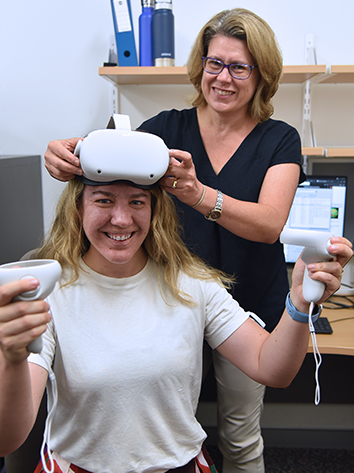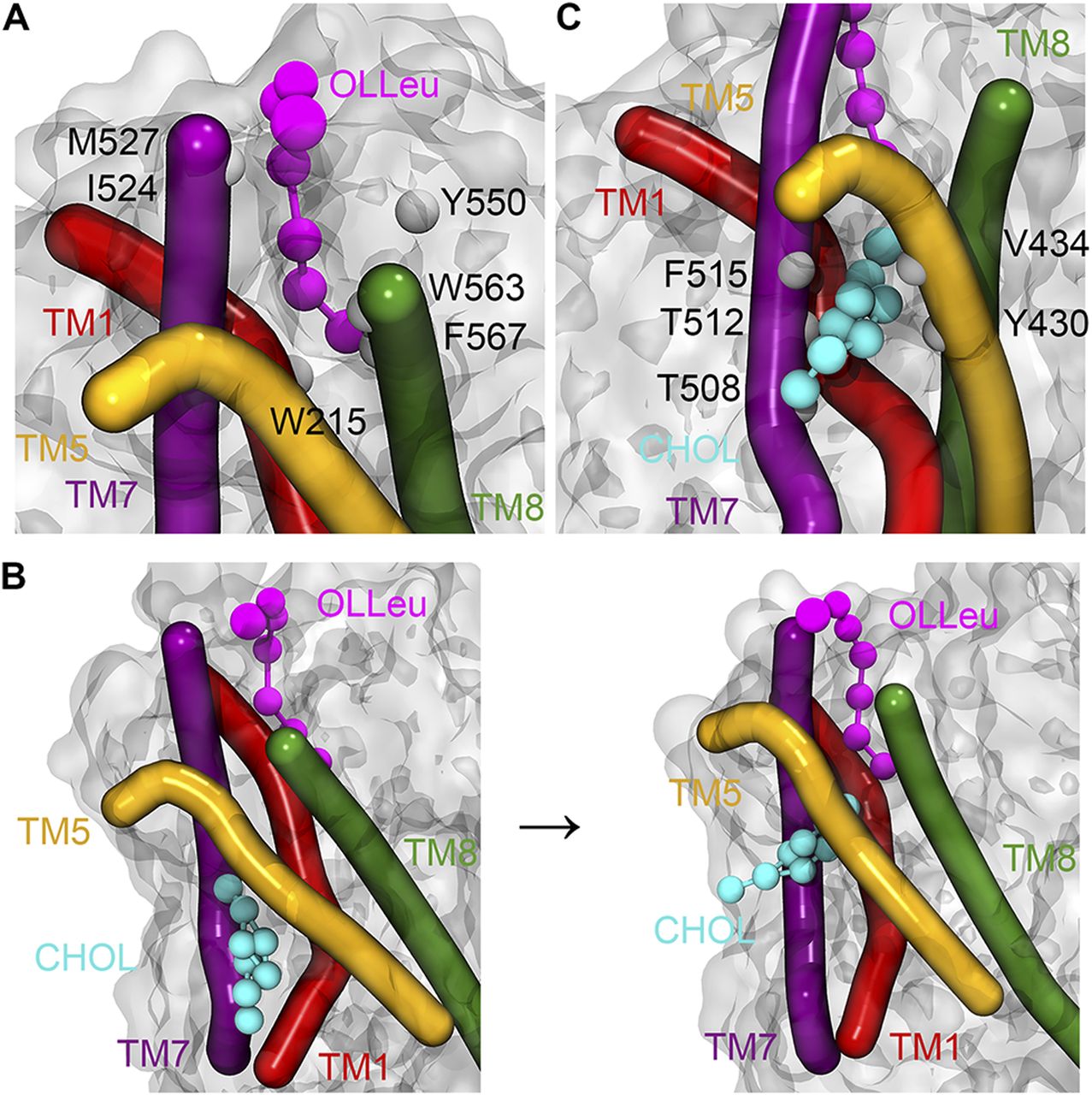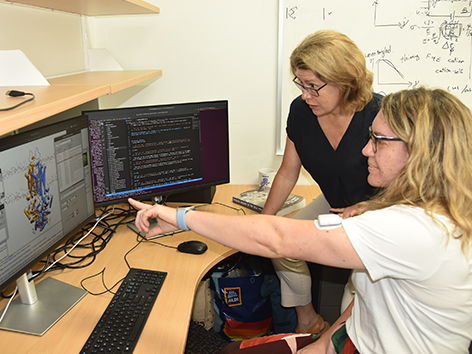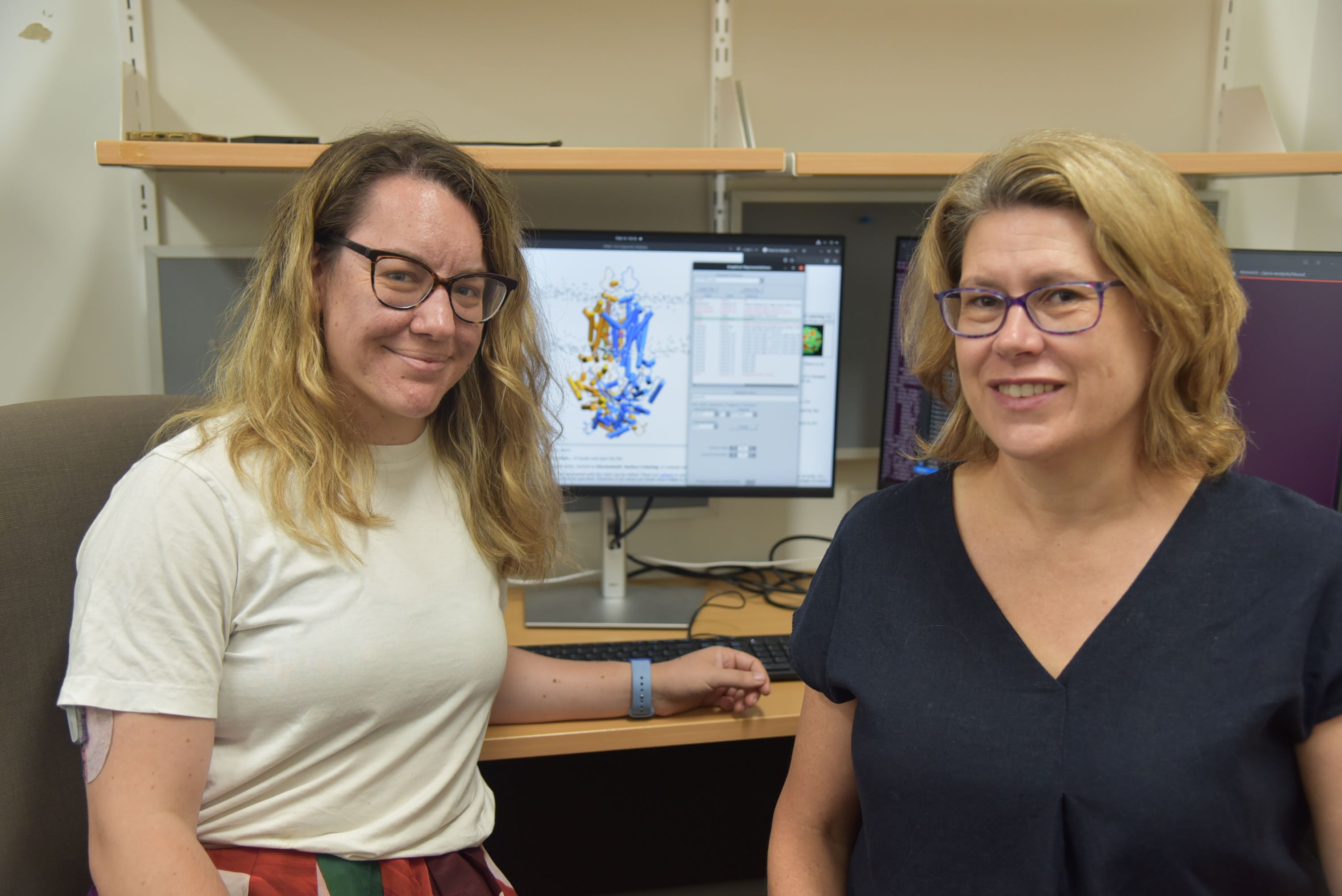Professor Megan O'Mara's research sits at the interface of chemistry, biology, physics, and computer science.
Or, more simply, she uses gaming computers to solve the mysteries of the human body.

“It’s sometimes quite difficult to describe overall the work we do, but it definitely helps when you can point to a gaming headset and say ‘we use these’,” the AIBN Senior Group Leader says.
Using basic high school physics and multiscale modelling techniques, Professor O’Mara is exploring how changes in the biochemical environment of cell membranes alters membrane properties, and modulates the function of membrane protein.
Ultimately, Professor O’Mara’s goal is to see how these changes can lead to differences in the efficacy of pharmaceuticals and the design of biocompatible molecules: all of which leads to improved targeted drug delivery.
“This process can basically inform how medical treatments may work on an individual,” she says.
“Even more basic to that, you could say it's used to inform the development and design of therapeutics.”

Professor O’Mara is back at the University of Queensland after seven years in Canberra and the Australian National University’s Research School of Chemistry, where she was a Rita Cornforth Fellow and Associate Professor.
Her academic journey has taken her back and forth between Queensland and Canberra, either side of a three-year stint at the University of Calgary on a Canadian Institutes of Health Research Postdoctoral Fellowship.
She grew up in a small town in the Darling Downs, and Professor O’Mara credits her father, and her childhood living above an ambulance station for her interest in science.
She is also a passionate supporter of women in science, and supporting the career progression of young women in science.
“I think there's this whole leaky pipeline model, where you're losing women at each stage of the process. With undergrads, you actually have slightly more girls doing science in a lot of fields like biology and chemistry, biochemistry in particular, than you do guys.
“And then as you get to PhDs there, it's about 50/50. And then as you progress along you really drop down in numbers.
“Women progress in science when they can see representation at every rung of the ladder, when they can see people ahead of them at each phase of their career and they can see that there are possibilities and that it can be done.”
Read on to find out all about how this self-described biophysics geek aims to uncover the mysteries of the human body, and how we might develop new was to tackle health issues.
Megan what’s all this about video games? This is a science lab.
There’s a lot we can use gaming computers for!
We do simulations, where we take the structures of molecules and give them coordinates – basically using the same technology that CGI is based on.
We look at every molecule in a particular system to work out a number of things, such as how proteins move and bind drugs, how they transport drugs into the cell, how multi-drug resistance proteins from bacteria induce antimicrobial resistance by shipping drugs out, and also how the proteins and cell membranes structure themselves to give a biological function.

This is all actually not too different from the standard gaming systems people have in their loungerooms.
So essentially, you’re able to show how a molecule does – and might – move around?
Yep that’s it. Other people like structural biologists can get the coordinates of a protein, where every atom in that protein is… and we can put that into the computer system and see how the protein moves.
We also do this to show how drugs cross the cell membrane.
What’s the end goal here? It all sounds very interesting but is there a reason for it?
This process can basically inform how medical treatments may work on an individual. Even more basic to that, you could say it's used to inform the development and design of therapeutics.
If you can do this type of work in the computer and see how a drug will interact with a protein and bind to that protein to stop its activity in a disease pathway…. then you can tweak the chemical design of that in the computer to see whether that modification is going to be better or worse.
And it saves a whole lot of time and money, and you can feed that into the people doing the experimental science.
How did you come to be working in this field? Where did the science journey begin for you?
I'm originally a Queenslander. I went to high school on the Darling Downs. I was a bit geeky as a kid, interested in science, interested in medicine.
I suppose I was just really interested in how things worked. In primary school - I think I was in year five – we had a class project where we had to build a rocket that was powered by soda bulbs.
My dad was always very mechanical. He was in the Ambulance Service, and we lived on top of the ambulance station out at Pittsworth. But before that he was an electrician. And so, with the rocket we tinkered around a lot and I got really interested in the science of it all.
If you grow up around ambulance centres, which is unusual, there's always a lot of signage and material around first aid courses and everything. There are things like a human dummy that you can learn anatomy from and stuff like that. So I always had those kinds of things around.

Did you always see yourself working at the bio-nano interface?
Not really – I started with a degree in medical laboratory science when I went to Canberra for uni. I worked in pathology labs for about four years afterwards, got really bored, hated it, decided to do something else.
I think it’s good if your interests and your research changes. Certainly if your research doesn't change throughout your career, then you're doing something wrong. You’ve got to grow and differentiate and find new problems that you can look at.
Tell about some of these ‘problems’ your group is investigating?
One of the things is we're designing drugs to involved in the computational design of drugs for chronic pain. We've found - in collaboration with people from UTS and University of Sydney - a group of compounds that inhibits pain (inhibitor) and they’re based on molecules that are similar to a fish oil.
We've been able to show with our computer simulations that when this inhibitor binds to the protein, it actually recruits a molecule of cholesterol from the membrane which interacts with the inhibitor. And this bound cholesterol helps the activity of the inhibitor to dull a pain signal.
Other things we're looking at include polymers, and how we might be able to design polymers that kill that kill viruses. A lot of the antiseptics around and antibacterial wipes kill viruses but may also contribute to antimicrobial resistance in bacteria. So if we can design a polymer that just targets the virus we can stop the rise of antimicrobial resistance.
In your opinion, what has changed the most during your time in science academia?
What strikes me is that people who are starting university now, there's a lot more information around. When I was in Year 12 and I told my parents I wanted to go to uni and study physics, my dad said to me, “you know, you don't see many jobs for physicists in The Courier Mail”.
I think now there's so much more information about what's going on with research, and there are a lot more opportunities because people are aware of what's happening.
I'm also very interested in women and career progression. There's this whole “leaky pipeline” model, where you're losing women at each stage of the process.

With undergrads, you actually have slightly more girls doing science in a lot of fields like biology and chemistry, biochemistry in particular, than you do guys. And then as you get to PhDs there, it's about 50-50. And then as you progress throughout your academic career, the percentage of women really drops down.
Women progress in science when they can see representation at every rung of the ladder, when they can see people ahead of them at each phase of their career and they can see that there are possibilities and that it can be done.
So representation on every rung of the career ladder?
Yeah. That just keeps motivating people. I've been quite lucky to have a number of strong female role models throughout my career, and also great support from men throughout my journey as well.
I think slowly we’re getting rid of unconscious biases. Whereas I think the generation before me, they really did it hard.
What, ultimately, do you hope to achieve in your work and research?
I guess my goal is for two things. One of them is to better understand how we can look at the cells and how the body works.
The body is almost like dark matter. We don't know how it works in a lot of ways. And by gaining knowledge, we can hopefully better treat diseases and improve people's quality of life.
The other thing that I'm trying to do is that in my chosen research area - as a computational biophysics geek - you don't have many women. There's not many women in computational fields.
It is growing, and I've networked with some amazing computational biophysics people overseas and here, but I want to create the awareness of female researchers in fields that are traditionally male-dominated, such as physics, chemistry and computational sciences.
Once you have more people coming into a field then you get different perspectives and it increases the knowledge about what needs to be done to build inclusion and community. Those different perspectives add depth, and understanding, and diversity.



